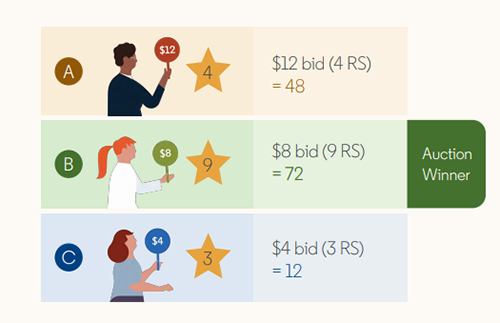Answering the Most Frequently Asked Questions About LinkedIn Ads Auction
When you think of a real-life auction, it’s possible the first thing that comes to mind is a fast-talking trader, stringing together words in an impossibly rapid succession while urging bidders in the room to up the ante. Not exactly the image of a calm or low-pressure environment.
With the LinkedIn Ads Auction, we aim to create the opposite type of experience: A simple interface that helps marketers achieve their goals, within their budget, at their own pace.
To help you launch ads with confidence and maximize spend efficiency, we’ve gathered some of the most frequently asked questions we hear about LinkedIn Ad Auctions. Read on for answers and special tips.
LinkedIn Ads Auction FAQ
1. How does the ads auction actually work?
Ad auctions on LinkedIn are fundamentally designed to accomplish two things: Providing members with a valuable experience, and helping advertisers reach the right individuals at a cost based on supply and demand.
To accomplish this, our auction system works like this: When you create an ad and define a target audience, you’ll bid against other advertisers targeting the same audience. These auctions take place instantly and automatically, and the winner has their ad served to members on the platform.
How is the winner of an ad auction determined? By two primary factors: your bid and your relevancy score. Your bid is based on how much you value the desired action, while your ad’s relevancy is calculated by an algorithmic predictive model reflecting how likely our system believes that a given member will engage with or convert from a particular ad.
There are three different bid types available: Maximum Delivery, Target Cost, and Manual. All are tailored to meet different preferences and needs. Learn about them here.
2. How do I make my campaign more competitive in an ads auction? Where should I look to make edits?
A competitive bid level will get you in the door, with a chance to win. LinkedIn offers bid tips and suggestions within Campaign Manager to guide you, and our bidding strategy resources may also prove helpful. Beyond that, the key is to improve ads relevance. This will increase your chances of not only winning ad auctions, but doing so with more efficient spend. The example below shows how a strong relevancy score can actually beat out a higher-priced bid:
So naturally, the next question is: How do I increase the relevancy of my ads? Here are a few key tips:
- Be thoughtful in selecting your target audience, using the extensive filters available on LinkedIn — such as Job Title and Seniority — to zero in on the exact members who are most likely to respond to your ad. (That said, be careful not to hyper-target; we advise a target scope of at least 50,000 members for Sponsored Content.)
- Test variations of your ads with different images, introductory text, calls-to-action, or destination URLs to determine what ad content resonates best with your audience.
- Keep a close eye on your ad performance and identify characteristics or techniques that are driving higher engagement. Small tweaks can sometimes go a long way. That being said, if you are uncertain on how to bid or don’t have the time to closely manage, we recommend using the Maximum Delivery bid type, which will do the work for you.
- Use the Forecasting Tool before launching and during a running campaign to gain predictive insight into the likely outcomes, and spot opportunities for improvement.
Find more tips about optimizing your ads on LinkedIn here.
3. What is the Campaign Quality Score and how do I improve it?
Since the relevancy scores for ads are not shared publicly, Campaign Quality Score (CQS) serves as a transparent proxy and directional tool for advertisers. This metric is based on the Predicted Click-through Rate (pCTR) of your ad, relative to its competitors across all auctions in which it participates. CQS operates on a normalized 1-to-10 scale (10 being best) and the scores are calculated daily for active Sponsored Content campaigns.
Given that CQS is a proxy for relevancy score, you can improve it by following the same tips and recommendations mentioned above. Testing and reviewing different variations of visuals, copy, CTAs and destination URLs can help improve relevance to your audience. Experimenting with different approaches and alterations is the most effective way to strengthen Campaign Quality Scores.
4. I am running more than one campaign. Are they competing against one another?
No, you’ll only compete against other advertisers targeting the same audience. Competing campaigns from within the same account are prioritized and filtered out prior to the auction. So while one of your campaigns will take precedence, it will not drive up the auction price for your other campaigns. (Note, however, that if campaigns are running from the same advertiser but from different business accounts, their ads may compete against one another.)
5. My campaign has more than one ad. How does that affect the auction?
We only select the best-performing creatives in a campaign and then introduce it into the auction, so your own creatives from the same campaign will never compete against one another. Performance is determined by historical audience engagement, or if a creative is new, we look at similar campaigns and creatives.
6. How do ad rotation options play a role in the auction?
As we mentioned earlier, testing variations of ads is instrumental in raising your CQS and driving the best possible ad spend efficiency. Ad rotations make this easy to do.
When using this tool, which is found in the creative settings tab in Campaign Manager, you'll be provided with two options:
- Optimizing for performance: Platform will initially send all ads equally, then quickly dictate a winner and it will be sent to auction at a higher rate.
- Rotating ads evenly: All of your ads will be given an opportunity to compete in the auction. (Note that better-performing creative will still usually see more impressions under this option, since ad performance is a key factor in auction outcomes.)
We recommend testing two or three ad variations per campaign, but you can add up to 100.
Lights, Camera, Auction!
We hope this article provides clarity and helps you set up your auctions with confidence. The right bid and the right relevance will lead to your ads being seen by the right people on the world’s largest professional network.
For more guidance and resources, we encourage you to check out our latest auction tips to optimize on LinkedIn. And to also subscribe to the LinkedIn Marketing Solutions Blog.






